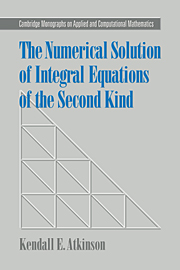Book contents
- Frontmatter
- Contents
- Preface
- 1 A brief discussion of integral equations
- 2 Degenerate kernel methods
- 3 Projection methods
- 4 The Nyström method
- 5 Solving multivariable integral equations
- 6 Iteration methods
- 7 Boundary integral equations on a smooth planar boundary
- 8 Boundary integral equations on a piecewise smooth planar boundary
- 9 Boundary integral equations in three dimensions
- Appendix: Results from functional analysis
- Bibliography
- Index
7 - Boundary integral equations on a smooth planar boundary
Published online by Cambridge University Press: 27 March 2010
- Frontmatter
- Contents
- Preface
- 1 A brief discussion of integral equations
- 2 Degenerate kernel methods
- 3 Projection methods
- 4 The Nyström method
- 5 Solving multivariable integral equations
- 6 Iteration methods
- 7 Boundary integral equations on a smooth planar boundary
- 8 Boundary integral equations on a piecewise smooth planar boundary
- 9 Boundary integral equations in three dimensions
- Appendix: Results from functional analysis
- Bibliography
- Index
Summary
A popular source of integral equations has been the study of elliptic partial differential equations. Given a boundary value problem for an elliptic partial differential equation over an open region D, the problem can often be reformulated as an equivalent integral equation over the boundary of D. Such a reformulation is called a boundary integral equation, and we will often refer to it as simply a BIE. As an example of such a reformulation, Carl Neumann [398] used what is now called the geometric series (cf. Theorem A.1) to investigate the solvability of some BIE reformulations of Laplace's equation Δu ≡ 0, thereby also obtaining solvability results for Laplace's equation. As a second example, the original work of Ivar Fredholm on the solvability of integral equations of the second kind (cf. §§1.3, 1.4 in Chapter 1) was also motivated by a desire to show the existence of solutions of Laplace's equation.
Various BIE reformulations have long been used as a means of numerically solving Laplace's equation, although this approach has been less popular than the use of finite difference and finite element methods. Since 1970 there has been a significant increase in the popularity of using boundary integral equations to solve Laplace's equation and many other elliptic equations, including the biharmonic equation, the Helmholtz equation, the equations of linear elasticity, and the equations for Stokes' fluid flow.
- Type
- Chapter
- Information
- The Numerical Solution of Integral Equations of the Second Kind , pp. 306 - 383Publisher: Cambridge University PressPrint publication year: 1997



